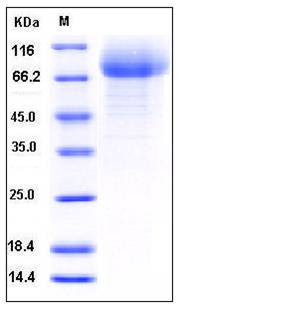Mouse CD36 / SCARB3 Protein (His Tag)
FAT,GPIV,Scarb3
- 100ug (NPP3228) Please inquiry
| Catalog Number | P50422-M08H |
|---|---|
| Organism Species | Mouse |
| Host | Human Cells |
| Synonyms | FAT,GPIV,Scarb3 |
| Molecular Weight | The secreted recombinant mouse CD36 consists of 421 amino acids and has a calculated molecular mass of 47.8 kDa. As a result of glycosylation, the apparent molecular mass of rmCD36 is approximately 80-90 kDa in SDS-PAGE under reducing conditions. |
| predicted N | Gly 30 |
| SDS-PAGE |  |
| Purity | > 92 % as determined by SDS-PAGE |
| Protein Construction | A DNA sequence encoding the extracellular domain of mouse CD36 (NP_001153030.1) (Gly 30-Lys 439) was expressed, with a polyhistidine tag at the C-terminus and a signal peptide at the N-terminus. |
| Bio-activity | 1. Measured by its binding ability in a functional ELISA. 2. Immobilized human RSPO1-His (P11083-H08H) at 10 μg/mL (100 μl/well) can bind biotinylated mouse CD36-His (P50422-M08H), The EC50 of can bind biotinylated mouse CD36-His (P50422-M08H) is 0.1-0.4 μg/mL. |
| Research Area | Cancer |Signal transduction |Metabolism |Types of disease |Metabolism in Cancer |
| Formulation | Lyophilized from sterile PBS, pH 7.4 1. Normally 5 % - 8 % trehalose, mannitol and 0.01% Tween80 are added as protectants before lyophilization. Specific concentrations are included in the hardcopy of COA. |
| Background | The cluster of differentiation (CD) system is commonly used as cell markers in immunophynotyping. Different kinds of cells in the immune system can be identified through the surface CD molecules which associating with the immune function of the cell. There are more than 320 CD unique clusters and subclusters have been identified. Some of the CD molecules serve as receptors or ligands important to the cell through initiating a signal cascade which then alter the behavior of the cell. Some CD proteins do not take part in cell signal process but have other functions such as cell adhesion. Cluster of differentiation 36 (CD36), also known as FAT, SCARB3, GP88, glycoprotein IV (gpIV) and glycoprotein IIIb (gpIIIb), is a member of the CD system as well as the class B scavenger receptor family of cell surface proteins. CD36 can be found on the surface of many cell types in vertebrate animals and it consists of 472 amino acids and is extensively glycosylated. It is an integral membrane protein primarily serving as receptors for thrombospondin and collagen and by the erythrocytes infected with the human malaria parasite. The role of CD36 as a cell surface receptor has been extended to that of a signal transduction molecule. |
| Reference |
